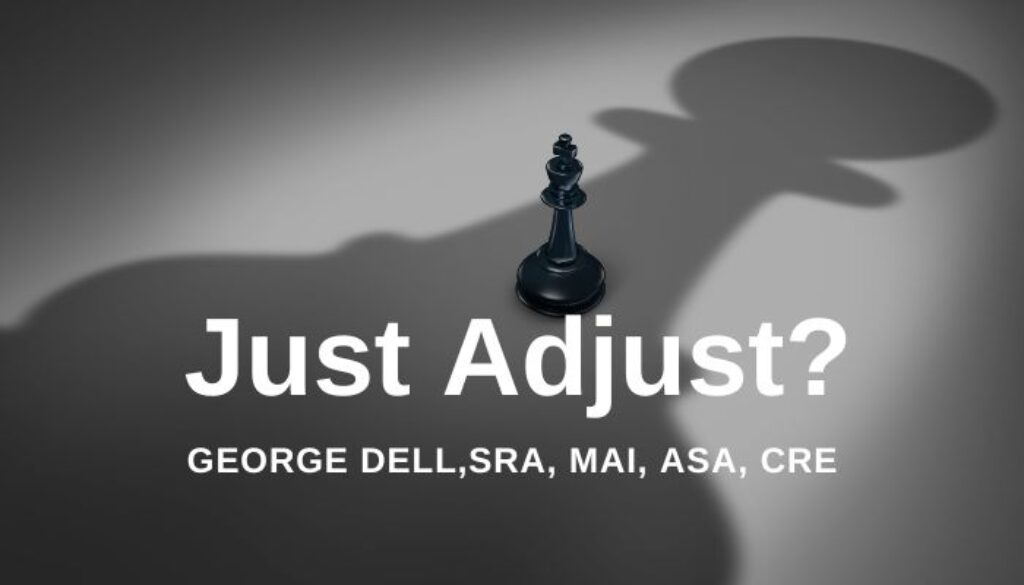A dictionary definition of “adjust” is: “alter or move (something) slightly in order to achieve the desired fit, appearance, or result.”
When I “carefully” pick some comps, I use my judgment to need as little fudging as possible. But it never seems to work out just right. There are three practices to adjust the fudging:
- Pretend some adjustments are not really needed, or too hard to figure out.
- Pretend you know a “reasonable” adjustment amount.
- Pretend you have magical calculations,
If it doesn’t work out, just adjust the adjustment until things come closer together. Of course, this is arbitrary, ‘cause the comps picked — determine the outcome, adjusted by my adjustments.
This is the second in an intended coming posts on the reality and the fallacy of adjustments. Is this heresy? We all know adjustments are necessary. We have standards! We have been told over and over how important are adjustments. Hundreds of times in The Appraisal of Real Estate, and in all the courses required for licensing and designations.
Adjust. Except when you don’t need to adjust. Or can’t.
We are taught that sometimes you just cannot calculate or reckon an adjustment. Sometimes you can just apply a “judgment” adjustment! And best of all, sometimes you can just use “qualitative” analysis, when you cannot quantify or “educatedly guess” an adjustment.
What is not clear is when you can and when you can’t “reasonably” reckon an adjustment. Not much of a science help here. You use your judgment to determine whether your judgment is enough.
One more problem. The goal of appraisal under USPAP is to be credible, defined as “worthy of belief.” (Strive for what others will believe, want to believe — not what is right!)
So the goal is not reliability or usefulness! For a loan collateral, an investment decision, or just plain fairness in legal or tax affairs. Not reliability. Not usefulness. Not fairness. But worthiness of belief! The goal is salesmanship, not good analysis. Belief, not truth. Justification, not results. Explanation, not transparency!
Form your opinion, then figure out how to support it. Biased or not! Justify, not analyze! As the definition above says: “achieve the desired fit, appearance, or result.”
Then we have a strange thing, from “the nation’s foremost authority on the valuation profession” (self-declared). An apparition: USPAP says nothing about adjustments. Not one word! Not even defined.
In The Appraisal of Real Estate, the word appears over 600 times. But – – it is never defined. But trust me, I know an adjustment when I make one!
In coming posts of this Analogue Blog, we will look at the many issues around “adjustments.” Everyone knows what one is, but no one seems to be able to define it or show how to calculate it.
We even have conflicting instructions about sale conditions and time adjustments.
In the Stats, Graphs, and Data Science class, we present what we do know, and how to calculate what can be calculated – and how to handle the rest. EBV©, (Evidence Based Valuation) is the answer.

October 11, 2023 @ 3:02 am
Adjustments are the contributory value of one more square foot, one more bath, one more garage stall, a rank of view, quality, condition, dissimilar financial terms; any difference between otherwise equal properties.
October 12, 2023 @ 1:45 pm
There in lies the problem. Which difference is causing the adjustment. One more square foot, one more bed, one more bath or one more garage or one more degree of view. Equally proportionate? I doubt that. Adjustments are often confounding. You may never know! Paired sales? Maybe, maybe not. Many market conditions can be reliable indicators but not all indicators are reliable adjustments.
October 12, 2023 @ 3:56 pm
Start with adjustments that are related to cost. Do those with depreciated cost method. Then use adjusted pairs and sensitivity analysis for the non-cost differences.
October 16, 2023 @ 10:28 am
As I wrap up a 35-year commercial appraisal career, I’m disappointed in the lack of advancement of the “art and science” of real estate appraisal. Exhibit #1 is the adjustment grid. The process is circular and self-justifying. Why do we adjust sales? To account for the contributory value of differences between the subject property and the comparable sales, which should result in a narrower range of value indications for the subject property. How do we know we have the right amounts of contributory value? When we get a narrower range of value indications! There is no external source or validation for these adjustments – they are simply made-up numbers or percentages, engineered to get to a result. If a 10% adjustment for the condition of a sale isn’t enough, let’s use 20%! Or 5%. Whichever gets us to a narrower range and our value target. We don’t even ask whether buyers or sellers use adjustment grids (they don’t). Dear reader, did you use an adjustment grid when you bought your house? I doubt whether even appraisers use them. Does anyone use them in other contexts? Did you use an adjustment grid when you bought your car – adjusting for horsepower, or trunk space in cubic centimeters? Do stock analysts use them to estimate fair value for stocks? Why are appraisers so uninterested in how people actually make economic decisions in the marketplace? Multiple Nobel Prizes have been awarded to researchers of behavioral economics and game theory. But almost none of these insights have been applied to real estate decision-making and market behavior.